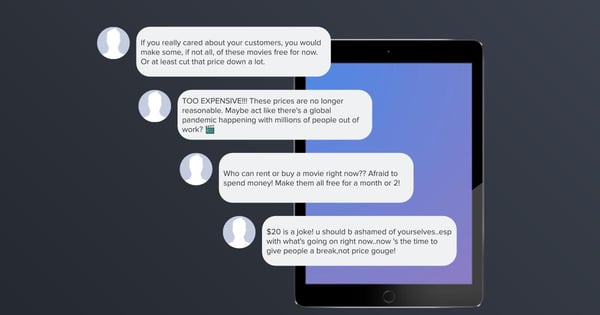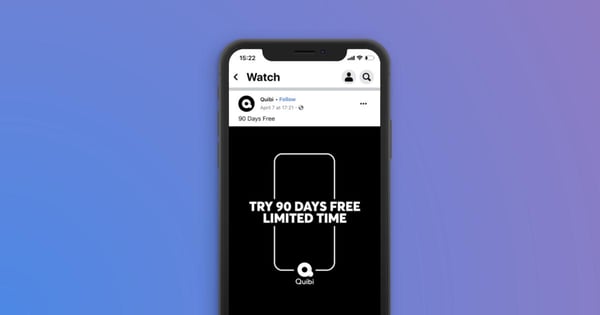
Challenges Faced By Streaming Services On Social Media During COVID-19
As the world stays at home, what does this mean for streaming services?
While industries around the world grapple with the impact of COVID-19, the streaming market is seeing a big rise in demand. As more people are staying home in front of their televisions and mobile devices, streaming services have become a major source of entertainment.
Warner Media’s Chief Research Officer, Cheryl Idell, reported that HBO Now has seen an overall 40% spike in viewership since March 14, compared to its four-week average. Meanwhile, Disney+ doubled its number of subscribers from 28 million to 50 million in only three months - just when the virus started to spread in early February. Additionally, Google searches for “Netflix” have skyrocketed as the coronavirus outbreak dominates headlines. After the first week of April 2020, Netflix’s popularity score as a Google search term jumped to 100, a 142% increase from the previous year.
According to IZEA’s study, 66% of social media consumers believe their social media usage habits will significantly increase during the COVID-19 confinement. As audiences are spending more time scrolling through different social platforms, they may become more critical and attentive to the content they digest.
This post highlights some of the challenges facing streaming services during this period and outlines a few ideas on how they can overcome these challenges, as well as showing examples of streaming services doing great on social.
Social media challenges faced by streaming companies during COVID-19
1. Consumers being reluctant to pay high subscription fees as household budgets tighten
As uncertainty for the future continues to arise and the danger of an economic recession and job losses loom, saving money is becoming a major priority for most people. With streaming services being perceived as more of a luxury than a necessity, people may not be willing to pay or keep paying for a streaming service.
In fact, this reluctance to pay for streaming content is already being reflected in user comments on social media. Many people are turning to social media to ask big streaming players to reduce their prices or even to provide free offerings for the time being.

These comments are found on an Amazon Prime Facebook ad and many streaming companies face similar engagement.
Consumers want brands to be understanding of the situation and to act on it. In fact, Edelman’s survey of 12,000 people in 12 different markets titled “Brand Trust and the Coronavirus Pandemic” concluded that people expect to hear from brands more than ever during this time. 83% of the people surveyed expressed that they want brand messaging to communicate empathy and support with the struggles customers face.
Responding actively to users asking or complaining about pricing can show the streaming service's audience that they're actively listening to user feedback. Producing high quality content is, as we all know, far from free and not all streaming sites can lower their prices, but some have ran specific campaigns during COVID-19 offering certain content free of charge.
For instance, HBO offered some programming for free without a subscription during April to encourage people to stay home. Additionally, Apple recently made some of its Apple TV+ originals free to watch, with no subscription needed. One of the available shows includes Oprah talks on COVID-19, which offers hope and encouragement during this pandemic.
2. A rise in customer complaints
The drastic spike in content consumption could put streaming infrastructure under strain. In a bid to preserve the user experience and internet speeds for everyone, the European Commission urged streaming platforms to switch to Standard Definition as the default viewing option.
This temporary measure has already been implemented by Netflix, Disney+, Apple TV, Amazon Prime, and YouTube. While many subscribers are supportive and understanding of these measures, others see this as another reason to air their dissatisfaction.
Additionally, many customer support teams are having to significantly change their processes as agents are required to work from home. This may lead to a backlog in customer complaints and unresolved tickets, triggering complaints on social media about the speed of customer service.
Negative feedback and a rise in complaints can be damaging to a brand’s reputation if not handled correctly. To prevent these types of comments from escalating and turning into a crisis, streaming companies can take action. For instance, brands can actively respond to complaints by apologizing in advance for possible delays and longer wait times, while assuring their audience that they are doing their best to address and solve their concerns as soon as possible. Brands can also tap into 1-on-1 messaging via Facebook Messenger to offer personalized support or to guide customers to a self service channel where they can find answers to their questions.
3. The quest for new content
People are bingeing more content than ever before as they look for ways to stay entertained and ways to cope with social isolation. Onepoll surveyed 2,000 Americans with access to at least one streaming service and found that the average person is now streaming eight hours of content per day, double the number of hours from before the pandemic’s spike.
As streaming consumption continues to rise, keeping up with subscribers' demand for new content can be quite challenging. Due to COVID-19, the entertainment industry has been forced to delay or suspend production on several upcoming movies and shows. Apple, Netflix and Disney for instance, were the first of the major studios to halt productions. Little America (Apple TV+), Russian Doll (Netflix), and Friends reunion special (HBO Max) are some of the shows that have been put on hold indefinitely before production even started.
4. A new wave of increased competition
With more newcomers entering the arena this year, the streaming wars don’t seem to be ending anytime soon. Apple TV+ and Disney+ gave life to a new wave of competition in 2019, but it hasn’t stopped there.
This year, consumers are expecting to witness three more debuts on the market - Quibi, Peacock, and HBO Max. Quibi took the first step, launching its service in the first week of April. The mobile-only subscription of short-form video streaming hit 1.7 million downloads within the first week of its release.
As people stay at home, this is actually an opportune time for streaming services to advertise on social media as advertisers in many other industries are cutting their spend, which has pushed advertising costs down. With rates being in the advertisers’ favor and more and more people spending more time on social media, now is the time for streaming companies to take advantage of reaching more potential customers.
All these three newcomers seem to get it, as bundle offers, 90-days free trials, and freemium models are being advertised as their entry strategy, such as the example of Quibi’s ad below:

However, taking an active role in engaging with customers along with advertising attractive sign up offers is essential to succeed, especially these days. Streaming brands need to work on building trust, loyalty and a new level of connection with consumers to stand out in this highly competitive landscape. Edelman’s report found that 60% of people are switching their purchasing decisions to brands that they absolutely can trust during these times.
So, what should streaming platforms do in such unprecedented times?
From our seven year experience within social media working with many leading disruptors, we recommend the following approaches for streaming companies advertising on social:
1. Don’t stay silent - communicate with empathy
When reacting to a global crisis, brands don’t want to come across as opportunistic or insensitive, but as empathetic help providers in times of isolation and boredom. Using social media to engage with customers is a great way for streaming companies to demonstrate their appreciation and care for their customers during this time.
Communicating what your company is doing to support people during the pandemic, sharing valuable information on how people can protect themselves, and building a sense of community are all examples of how brands can use advertising right now. 65% of Edelman’s study respondents said that a brand’s response in the current crisis will have a huge impact on their likelihood of purchasing from it in the future.
It is also important to remember that people are always keeping an eye on how businesses react. A Deloitte study on the current crisis found that, “People are paying attention to how organizations are responding, and purpose-based companies that show empathy will likely emerge as the leaders”.
2. Consider alternative types of content
Posting and promoting content on social media that has no value to your audience could trigger customer fatigue and disinterest in your brand. By spending more time scrolling through social media, customers easily get bored these days. To be able to capture your customers’ attention you may want to consider using alternative, creative and relevant content for them. While streaming companies can’t create this new content at studios at the moment, they can certainly innovate.
Creating unique and different types of content from what you are used to can really make a difference on the perception of your brand. Using your company's voice to inform people about important topics like self-care, mental wellness, how to cope with pandemic-related life challenges, among others is what people are expecting to see right now. 84% of respondents in Edelman’s report said that they want brands to be a reliable news source that keeps people informed.
A great example of a streaming service using social media in a unique way to inform its audience during these hard times is Netflix with its weekly live series “Wanna Talk About it?”. The popular streaming service announced that its teaming up with Instagram to launch the show, featuring stars from some of Netflix’s popular young adult content. They will be talking about self-care during COVID-19 with trusted mental health experts from various organizations.

3. Have a consistent customer engagement strategy
Responding to complaints and inquiries in incongruent ways through your online platforms will only cause confusion and frustration among your customers. That is why it is so important that your customer support team takes an effective and consistent response approach. However, when dealing with high volumes of engagement, succeeding at this can be quite challenging.
Streaming services can start by doing their best to take care of their loyal customers. Although potential new customers are also valuable during a crisis, it is important to first retain and satisfy existing subscribers by addressing their questions. Additionally, when issuing responses updating customers on the current situation, these responses should be simple, obvious, and informative.
4. Reprioritize goals
It is important that we all understand that what used to be a priority pre COVID-19, might not necessarily be one right now. In order to succeed during a global crisis, companies may need to be willing to take a short-term hit to their bottom line for a long-term gain. And to be able to do that, they may need to reprioritize.
71% of those surveyed in Edelman’s study said that brands and companies that placed their profits before people during the crisis would lose their trust forever. Putting consumer loyalty at such a stake in times like this can cause irreversible damage, especially when customer switching costs are low in the competitive streaming industry.
A key part of putting customers first is delivering consistent messaging that demonstrates empathy and compassion. Rather than just selling a service, demonstrate how what you offer provides social support and offers a sense of community. Additionally, if you're able to, offering free or lower-priced products can help people overcome the challenges this crisis presents and people will perceive your company as accountable during difficult times.